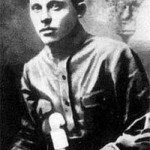
Opposition to the Bolsheviks and resistance to Bolshevik policies was not confined to the cities or military garrisons like Kronstadt. During and after the Civil War there were dozens of peasant uprisings around Soviet Russia. One official report from the CHEKA, dated February 1921, numbered these uprisings at 118. The largest occurred in Tambov, an agricultural province several hundred miles south-west of Moscow, in 1920 and 1921. During the Civil War, the Tambov peasants had opposed the Whites – but this did not make them supporters of the Bolsheviks. Tambov’s farmers had long been dissatisfied with Bolshevik policies, particularly forced grain requisitioning. This dissatisfaction grew through 1920, culminating in the formation of a political group called the Union of Toiling Peasants (UTP).
The UTP quickly became popular and, in December 1920, it issued a manifesto calling for political equality, land reform, an end to the civil war and various liberal reforms. The UTP was led by Alexander Antonov, a former SR who had served as a police officer under the Provisional Government before reverting to terrorism and assassinations against Bolshevik targets. By late 1920 Antonov had formed a cavalry force of several thousand men which attacked Bolshevik strongholds around Tambov province. His ultimate goal though was to drive the Bolsheviks from Moscow. By 1921 Antonov’s army had more than 20,000 men, as well as supplies, weapons, an organised hierarchy and its own uniforms. Antonov’s troops were sometimes referred to as the Blue Army, to distinguish themselves from the Bolshevik Red Army, the counter-revolutionary White Army and the Ukrainian-nationalist Green Army.
Publicly, the Bolshevik hierarchy dismissed the Tambov army as nothing more than a rabble comprised of “bandits” or kulaks – and it rejected the manifesto of the UTP as propaganda written by the self-serving Antonov, who was the real architect of the Tambov revolt (Lenin went so far as to call their rebellion the “Antonovschina”). Privately though the Bolsheviks recognised the great threat that the Tambov army posed to Moscow, and it took stern measures to quell the revolt. Some of the Red Army’s most experienced commanders and battalions were summoned, including a combat-hardened division led by Mikhail Tukhachevsky. They were accompanied by Cheka units, some containing Chinese ‘internationalists’ who had been recruited from the east, known for their ruthlessness and brutality. In total more than 100,000 Red troops were sent into Tambov, carrying orders to shoot all suspected rebels; to use poison gas to flush them out of hiding places in the forest; to construct concentration camps and capture civilian hostages. These tactics were brutal and indiscriminate but they worked; by mid-1921 the uprising had been suppressed. Antonov evaded capture until 1922 when he was killed during an arrest attempt.
© Alpha History 2014. Content on this page may not be republished or distributed without permission. For more information please refer to our Terms of Use.
This page was written by Jennifer Llewellyn, John Rae and Steve Thompson. To reference this page, use the following citation:
J. Llewellyn et al, “Peasant uprisings” at Alpha History, https://alphahistory.com/russianrevolution/peasant-uprisings/, 2014, accessed [date of last access].
